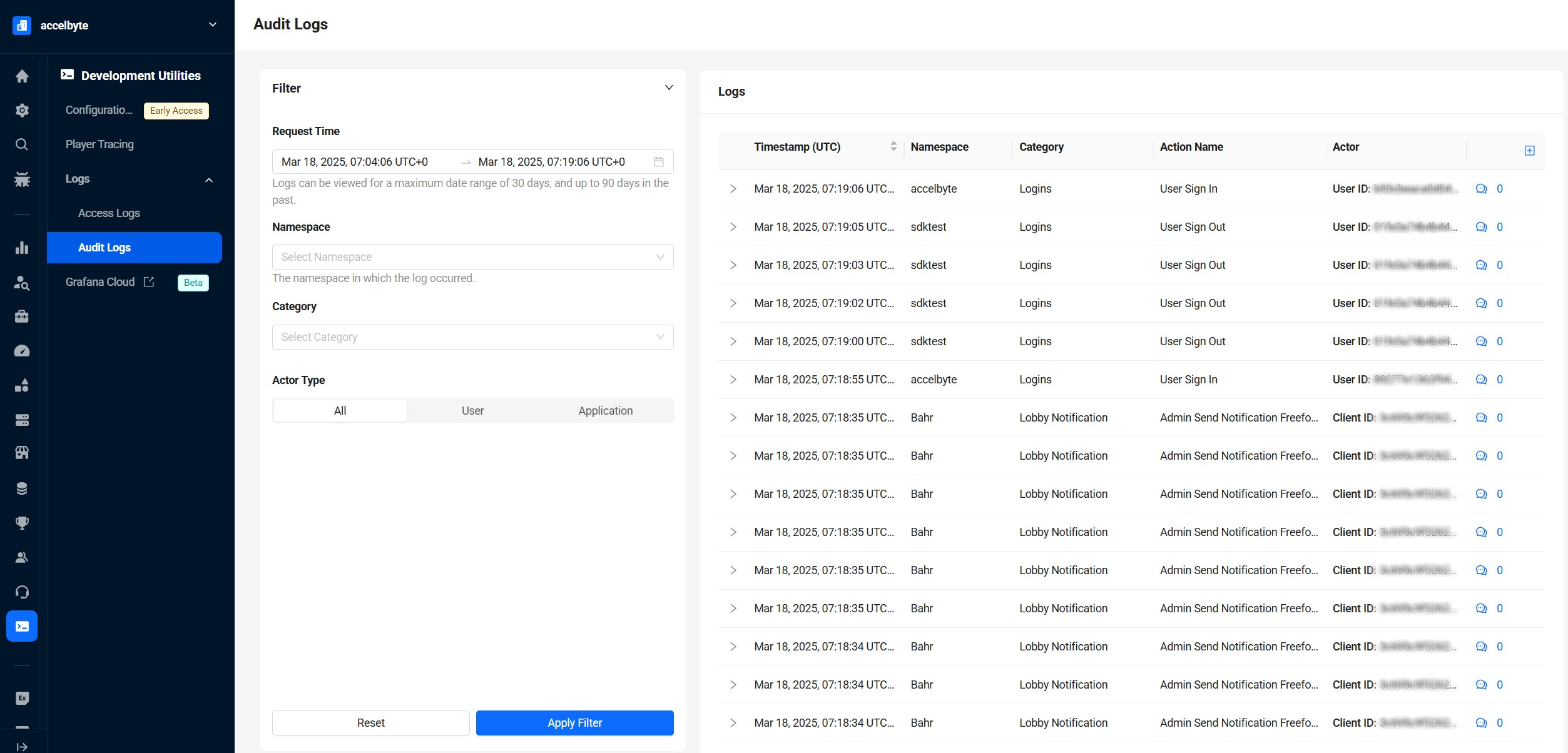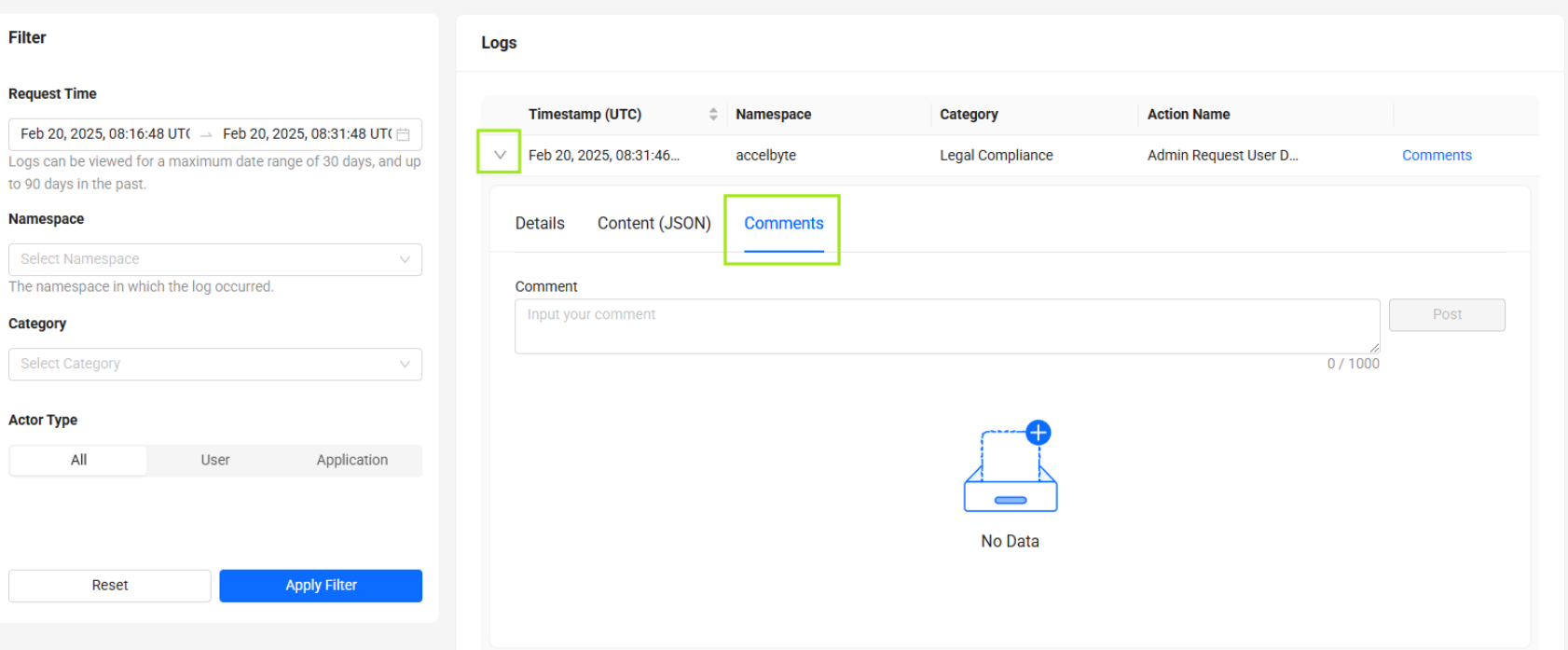Audit Logs
Overview
The audit logs are essential tools for AccelByte Gaming Services (AGS) administrators to track important changes. They are extremely useful when you need to detect a problem efficiently and react accordingly. By reviewing audit logs, systems administrators can track user activity, and security teams can investigate breaches and ensure compliance with regulatory requirements.
Prerequisites
- Access to the AGS Admin Portal.
- A publisher namespaces or a game namespace.
View audit logs in the Admin Portal
On the Audit Logs page, select any entry in the log to view the complete details. You can also use the audit logs filter. Follow these steps:
-
From the Admin Portal either search for "audit logs", or navigate to Development Utilities > Logs > Audit Logs.
-
On the Audit Logs page, you can view every log from every namespace you have access to.

-
Browse the list to find the log you want to check. You can also use the available filters on the left side of the page to search for specific logs. After selecting your filters, click the Apply Filter button to begin your search. The available filters are as follows:
- Request Time: filters the search by when a request was made. You can define the time range of the search by setting the start and end date and time in UTC format. The maximum period of time you can search for is 30 days.
- General filters:
- Namespace: limits the search to a specific namespace. If left blank, the logs returned by your search will come from every namespace you have access to.
- Category: limits the search to a specific category. To use this filter, type the name of the desired category into the box that appears. The option of the Category filter will be available when there is at least one log tracked. The category names must be entered as follows:
- Action name: limits the search to a specific action name. To use this filter, you must select the category first and the action name will show option accordingly.
- Object Type: limits the search to a specific object type. To use this filter, you must select the category first and the object type will show option accordingly.
- Object Identifier: filters the search by unique identifier of the resource affected by the event captured in this log activity. To use this filter, you must select the category first and type the Object ID.
- Actor Type: filters the search by actor. There are three options:
- All: filters the list to show logs performed by users and application.
- User: filters logs only performed by users.
- Application: filters list to only show logs performed by applications.
-
On the list, click on a log file to expand its contents.
- In the log's Details tab, you can see information about the activity that generated that particular log.
- Under the Content(JSON) tab, you can see the request bodies for the action generated in the log
View audit logs in the User Detail Page
Now audit logs are available on the User Details page, making it easier for admins to view activity logs for specific users. To view audit logs on the User Details page, follow these steps:
- Navigate to Lookup Users
- Search a User and click the View button
- On the User Details page, go to the Audit Log tab
- The specific audit logs for that user will be displayed
The displayed audit logs includes only the log of actions performed on the user account within the selected namespace
Audit logs Comments
You can add comments to each log in the audit log as a marker for other admins, making it easier to investigate by tracking user activity.
Add Comment
To add a comment to an audit log, follow these steps:
- Access Audit Logs (Audit Logs menu or in User Details).
- Find the log you want to comment on, expand it, and then click the Comments tab.

- Type your comment.
- Click the Post button to add the comment.
Edit Comment
To edit a comment, follow these steps:
- Locate the comment you want to edit
- Click the Edit button
- Modify the comment.
- Click the Save button to save the modification.
Delete Comment
To delete a comment, follow these steps:
- Locate the comment you want to delete
- Click the Delete button
- Confirm the deletion.
- The comment will be removed from the audit log.
Only the admin who created the comment can edit or delete it.